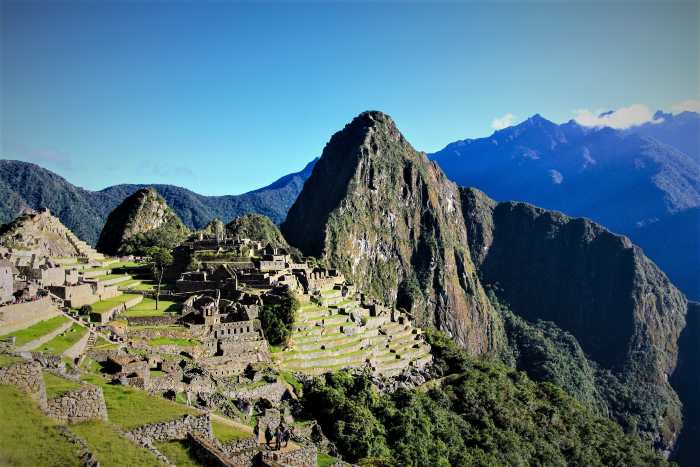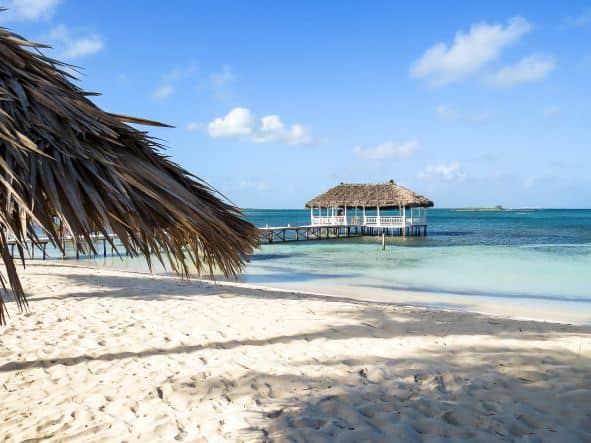Review Inca Trail Trek 4 Days: My Epic Inca Trail Experience (2024)
Putting one foot before the other at a slow hiking pace on the steep and seemingly never-ending uphill path surrounded by majestic mountain ridges on this day 2 of the four-day Inca Trail trek in the Peruvian mountains.
I am actually doing it, walking the spectacular Inca Trail to Machu Picchu in the endless mountains of Peru. And I am loving it; this hike is incredible!
If you are considering walking this old path to reach the ancient city, I can pretty much promise you that it is so stunning it will give you goosebumps almost every step of the way! (And a little shortness of breath, true).
Read on for general information about Peru and the Inca Trail regulations, or jump directly to the story of the hike by clicking “Inca Trail Day 1” in the table of contents below.
Hope you decide to do this epic journey! Enjoy!

Spektacular Inca Trail Trek 4 Days
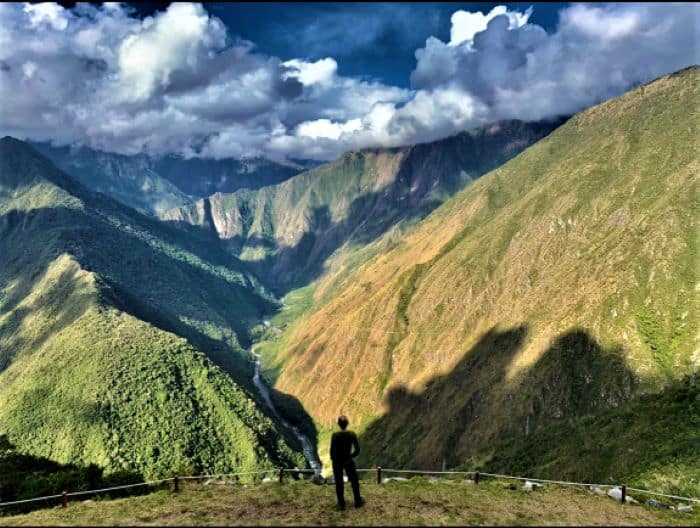
First, the stunning Inca Trail trek in the Peruvian mountains is very popular. To protect the path and the hundreds of ruins along the way, you must hike with a certified tour operator.
You can not set out on your own as a private adventurer.
I decided to walk with G Adventures, and this tour is my third experience doing epic tours with this worldwide small group company focusing on creating sustainable travel experiences.
Short Inca Trail Review
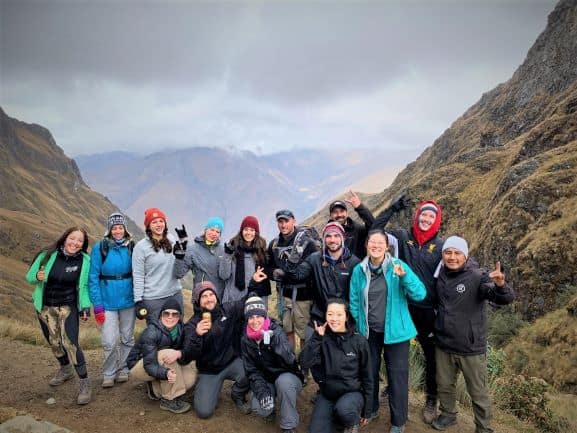
In conclusion, I highly recommend doing this Inca Trail Trek with G Adventures.
Inca Trail 4 Days Trek
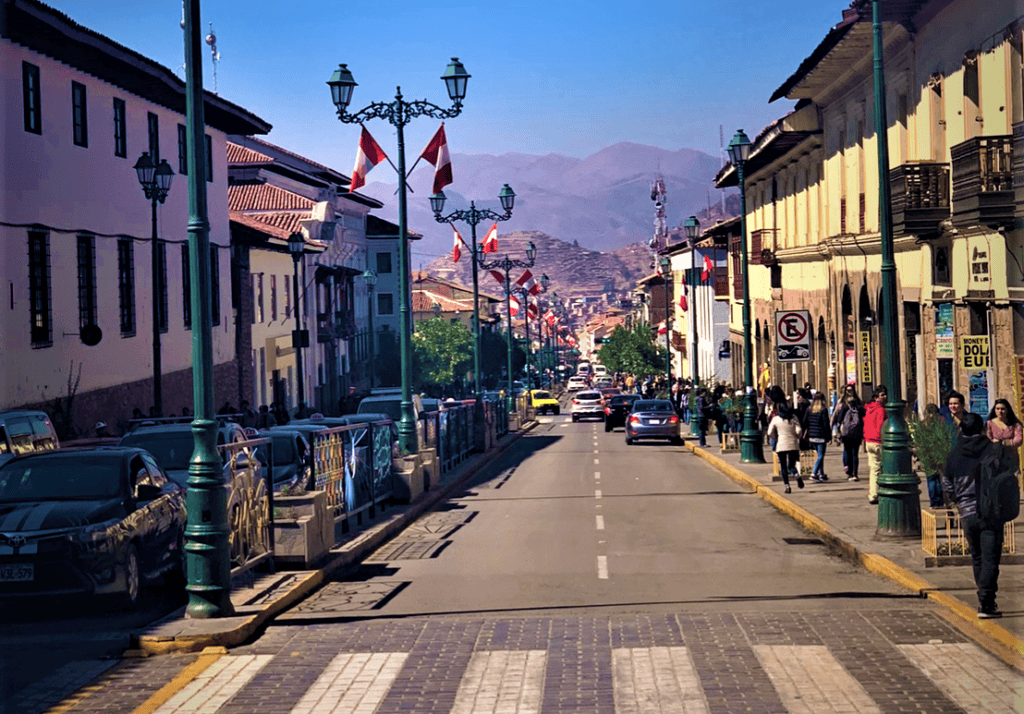
This article is about the four-day trek, but you can choose from a variety of organized tours, from the Inca Trail 2 days up to around a week.
The Inca Trail hike to Machu Picchu is part of the 23,000 kilometers (approx. 14,000 miles) of roads built by the Incas in South America.
This hike is the most famous trekking route in Peru and possibly one of the most spectacular treks in the Americas. The route of the Inca Trail hike starts from a point known as KM 82 at approximately 2800 meters.
From there, it climbs to a notable 4200 meters (less oxygen!) and then back down to Machu Picchu on the last day at 2430 meters above sea level.
Although the classic Inca Trail hike is “only” 42 kilometers in distance, there are a lot of ups and downs at noticeable altitudes and sometimes with slightly challenging terrain. Therefore, the trek as a whole is considered a bit challenging.
Depending on your experience, this might feel like lots of altitude if you are used to staying close to sea level, or maybe not so much if you have hiked in high-altitude mountains before!
I had not hiked to this altitude before and was wondering “how I would do,” as whether you get altitude sickness or not apparently does not directly correlate with your physical form. I was in good shape but was still at risk of feeling a bit sick from the altitude.
Luckily, I did not have any problems (and most people do not!), apart from the fact that hiking steep uphill above 4000 meters DOES require a bit of extra huffing and puffing!
First: Inca Trail Trek Regulations
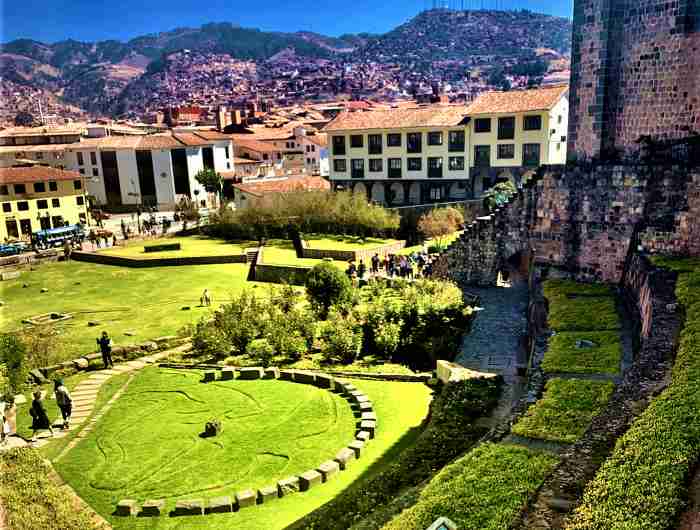
Hiking the Inca Trail is strictly regulated by the Peruvian government on many levels in order to take care of the ancient mountain trail and the relics along the way.
You need to book the trek with a certified tour operator, like G Adventures, who has all the permits needed to conduct the hike according to regulations.
Then, you will do the hike in a group with a qualified guide, sherpas, and staff who make sure the trek is conducted in accordance with the regulations of the mountain.
The number of daily trek starters on the Inca Trail hike and daily visitors to Machu Picchu are also limited.
There are different types of Machu Picchu hikes available, with various routes and lengths that you can choose from. Below, you find the relevant information about regulations for this season and links to further relevant pages.
📍 I only recommend services I love and trust on this travel blog! 🏆
If you use my affiliate links to make your bookings, the service provider will compensate me for my work at no extra cost to you! Thank you!
Regulations Inca Trail Trek 4 Days In Short

- The sale of Inca Trail tickets for the coming year starts in October each year.
- Inca Trail is open all year except for February, when the route is closed for maintenance.
- All Inca Trail hikers must book an organized trek through an authorized Inca Trail tour operator.
- A maximum of 500 persons per day, including guides and porters, are allowed to start the Inca Trail.
- The number of daily permits may be reduced in accordance with regulations.
- An Inca Trail hiking group will not exceed 16 persons.
- The spaces are limited and popular, so book your Inca Trail well ahead of time for your journey.
- Your certified tour operator will provide all the permits you need to hike and enter Machu Picchu.
- Porters are not authorized to carry more than 14 kg, so pack light
Inca Trail Booking Next Season
If you want to check out the Inca Trail booking options, research the various Inca Trail treks you can do with G Adventures by following the link below to find your perfect one!
Pre-Hike: Inca Trail Preparations In Cusco
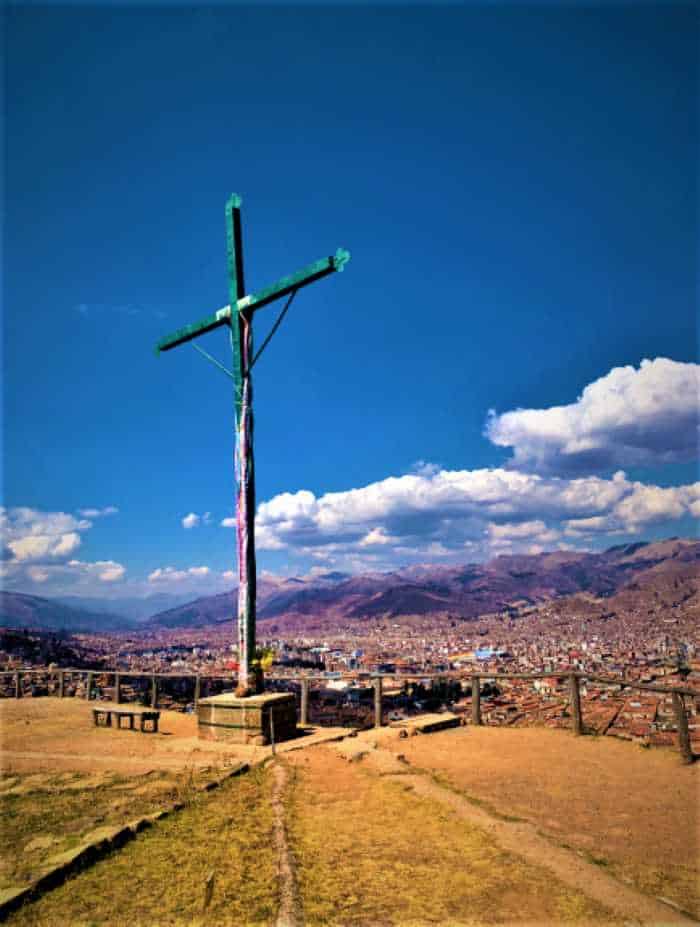
I traveled to the Inca Trail starting point via Lima and from there to the Peruvian mountain city of Cusco, where I spent a few days before the trek started.
Cusco is situated at around 3400 meters altitude and circa 80 km from the start point of the Inca Trail hike, and it is a really beautiful city.
The intention is to get used to the altitude and hopefully not suffer any problems like altitude sickness during the trek.
The highest point of 4200 meters is not extreme, but apparently, you never know if you are prone to altitude sickness or not or when it may occur.
Even if you are not doing the Inca Trail, you should visit Cusco; check out this 5-day itinerary for Cusco to see what you can do there!
As I am not an experienced altitude trek person, I decided that some acclimatization would be smart, and Cusco is a beautiful mountain city with just the vibe I had imagined beforehand.
There are a lot of fun things to do in and around Cusco for a few days, and one of them is preparing for your incredible hike with another incredible hike to Rainbow Mountain.
The people, the colorful details, the endless airy hazed mountains surrounding the city. Cold, crisp, and stunning!
Also, things I did not know. For example, all the houses and buildings have bright orange terracotta roofs, and the temperature was rather low and chilly already in July!
Beautiful Kokopelli Hostel Cusco
I found the Kokopelli Hostel Cusco in one of my new solo-travel favorite apps; Hostelworld. Cocopelli had good reviews and a funny name – and vacancy.
The Cocopelli Hostel building is absolutely gorgeous!
It has just the kind of architecture I imagined for the Peruvian high mountains. The courtyard is large and light, made of dark woodwork and stone with no ceiling.
There is Wi-Fi for travelers to connect to home as well as space for fiestas, barbeque, and socializing with others.
The room was nice, tidy, and clean – although cold! One of the things I learned in Cusco is that the mountain Peruvians keep their houses cold and put on more clothes instead of heating the house!
📍 I only recommend services I love and trust on this travel blog! 🏆
If you use my affiliate links to do your bookings, the service provider will compensate me for my work, at no extra cost to you! Thank you!
G Adventures Inca Trail 4 Days Cusco Headquarters
On day one of the trek itinerary, I met up at G Adventures headquarters in Cusco.
A lovely attic meeting hall where we are introduced to some of the other people in the group and go through the itinerary of the whole trek.
After the introduction, we headed downstairs to collect the equipment we needed for the trek.
Sleeping bag and sleeping pads, walking poles (I learned in Columbia trekking to The Lost City in Colombia that walking poles is very smart), and the rest of what we will need.
After all the practicals were done, I went back to my hotel to pack my bags as cleverly as possible getting ready. And at last, an early night to try to be well-rested for the days to come!
Heading for the mountains with only my daypack to worry about (Sherpas will carry all the heavy stuff on this trek).
Inca Trail Packing List
When making your Inca Trail packing list for the hike to Machu Picchu, I advise you to have a need-to-have mindset as you don’t want to carry more than you need to in the Peruvian mountains and high altitudes.
Also, remember to research the weather during the period you are walking the Inca Trail, especially the night temperatures, as it can get really cold in the mountains.
When I walked the Inca Trail with G Adventures, one of the things I learned was not to skimp on the nightly comfort (it was just September, so I thought temperatures would be friendly – but no).
Temperatures plummet when the sun sets! If you are offered a double sleeping mat, I recommend you say yes.
You will be carrying a small day pack yourself, while the porters will take the rest of your luggage, including a sleeping bag, mat, personal tent, etc, so be conservative.
Here are my best tips for an Inca Trail packing list that makes sure you have what you need (but not much more!).
Yey! Starting The Magic Inca Trail Hike!
Inca Trail Day 1 – Start At Wayllabamba Camp

Departing Cusco SUPER early in the morning (before breakfast) on a minibus, we are heading for KM 82.
KM 82 is the starting point of the whole Inca Trail hike, just outside of Ollantaytambo village. The day is a little grey and rainy, with low clouds and tiny droplets hanging in the air.
At the starting point, I will meet up with the rest of the trekkers who are part of my group on the Inca Trail with G Adventures.
As my bus arrives early at Ollantaytambo, I have time to shop for some extra chocolate bars and mosquito repellant as a last-minute thing just to be safe.
Also, I found a place that had already opened its doors and could serve me a smoking hot coffee and an omelet really quickly. Made my morning perfect.
As the rest of the participants arrived, we headed to a spot where all the trekking kit was neatly organized and dissembled.
I end up with a neat little daypack with water, some dry clothing, and chocolate bars. And, of course, the walking poles that I have come to love. All set for this Peruvian mountain adventure!
Quickly Learning To Appreciate The Porters, Or Sherpas
It does feel a little strange to have someone else “do my heavy lifting” for me. But in the higher parts of the trek, I am going to appreciate not having to fend for myself in the thinner air, of course.
On the first day of the Inca Trail 4 days trek, the path is not very physically challenging as we only climb a few hundred meters of altitude.
We are wandering through beautiful scenery with a variety of flora that changes with the seasons and also changes with the altitude. On this first day, we are passing several smaller ruin sites already, like Llactapata.
Upon seeing Llactapata for the first time, we are able to admire the amazing view of the impressive complex system of terraces.
It has been dedicated since ancestral times to the cultivation of food up here at more than 2800 meters of altitude.
Entering The High City Llactapata
The name, Llactapata, literally means “high city”. It is an important landmark on the Inca Trail located at the confluence of the Cusichaca and Urumba rivers.
These ruins were discovered in 1912, but not until later was it concluded that they were a resting point on the actual original old road to Machu Picchu.
Overall, it is an impressive ruin that is made up of the ceremonial center of Pulpituyoq.
The Wayllabamba camp is our first night camp, a tenting site where the Sherpas of course have arrived long before the rest of us, and our tents are already in place.
Sleeping mats and bags and everything is ready inside. What a luxury!
After admiring the old engineering art and intelligent systems built by the Incas, the trek continues. Today’s goal is the Wayllabamba camp situated at around 3000 meters altitude.

The first evening meal is also served exquisitely in a large “old fashion style” army tent with a long table and cutlery.
Feeling utterly pampered, after an amazing dinner that included three courses and snacks, I headed for my tent for a nice night’s sleep after a long first day.
I don’t know what I expected in the ancient mountains, but this was not it!

Day 2 will be a little more challenging as it includes passing the highest point of the trek – the Dead Woman’s Pass.
Day 2 Of Inca Trail 4 Days Trek – The Dead Woman’s Pass
Waking up early, ready for the second day of trekking the Inca Trail. I also realized that I underestimated the chilly night temperature in the Peruvian mountains in July.
I absolutely should have accepted the extra sleeping pad that I was offered; it is freezing! BUT- too late to ponder that now.
Even the wake-up on this trek is absolutely wonderful, consisting of the soft voices of the Sherpas outside the tent providing hot water for us to wash and start our day.
Following a nice mountaineer breakfast, we all packed our daypacks and slowly got ready to leave.
During the same time, the Sherpas packed the dining tent, the kitchen tent, and all the tents used by us. All assembled in different HUGE backpacks and set off for today’s hike.
Everything before I have my shoes tied and daypack in a ready-to-go position. Amazing, I feel a bit spoiled.
The hike starts early, heading for the long, steep path to Warmiwanusca, better known as the Dead Woman’s Pass, at 4198 meters.
Inca Trail’s Highest Peak Altitude IS Noticeable
The pace I chose for the day two trek is slow and sturdy. One foot before the other in a steady and determined manner below the acid threshold of my muscles.
After starting with a steep uphill path, we had a short “technical break” to adjust clothing and gear and catch our breaths before soldering on.
Although I have to say my breathing the last few hundred meters up to the Dead Woman’s Pass was a bit of a workout.
As we slowly ascend up the hill, I have to admit I feel the air is getting a bit lighter and thinner.
Because this was my first hiking ascent to over 4000 meters altitude, I was a little nervous about how my body would react as apparently you never can know for sure.
Luckily, apart from a light sense of needing to breathe deep for lack of juice, I did not feel sick or lightheaded or experience headaches or anything. Also, luckily, the views are awesome, making you forget at least half the struggle!
📍 I only recommend services I love and trust on this travel blog! 🏆
If you use my affiliate links to do your bookings, the service provider will compensate me for my work, at no extra cost to you! Thank you!
Inca Trail Hike “Summit” Push

For the last part of the ascent today before, I was able to actually spot the end of today’s uphill battle.
People before me (who started earlier of course, not that they walked faster) started shouting muffled ecstatic messages in the distance.
Excellent comrade motivation for us further back, and I found a little extra energy to send to my feet for the final push for the “summit”!
An absolutely super feeling taking the last few steps uphill for the day and being rewarded with happy smiles, high fives, and a summit beer from someone’s backpack.
The mountain ranges and scenery around the Dead Woman’s Pass (once I had caught my breath (and got some chocolate)) were impressive.
There were greenish blue mountains and ridges behind us and in front of us, and ridges above us both to the left and right higher up.
The point we were crossing really was a pass or a tiny ridge of a few meters before the descent started abruptly on the other side.
We stayed on the windy ridge at 4200 meters only in time to assemble the group and congratulate each other (and have a “summit”-beer).
Then, I started the much less challenging part two of the second trekking day – downhill!
Gratitude And Praise For Reaching The Inca Trail Summit
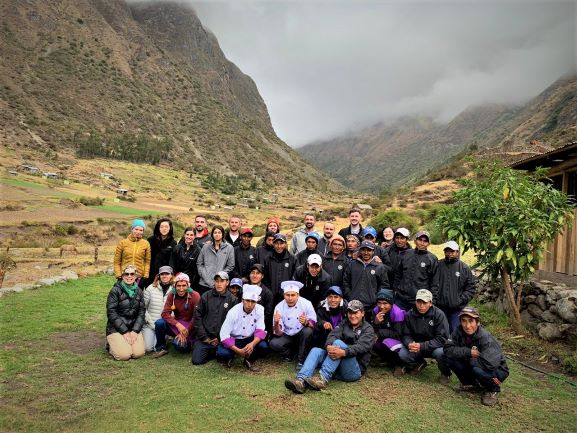
From the pass, it was all downhill, immediately out of the wind on a rocky path all the way to the campsite for the night.
This part of the hike is a little tough on the knees after several hours uphill, but apart from that, the path is a smooth descent.
At camp, the Sherpas were way ahead of us and ready with congratulations and high-fives for the accomplishment. Everyone was ready to serve drinks and snacks for us “rookie hikers” upon arrival.
My only responsibility for this part of the trek is to throw my shoes off outside my all-set tent this afternoon as well.
With no other chores, it is lovely to have a little nap and rest before dinner is served in the same immaculate manner as the day before.
My expectations beforehand about this five-day trek in the Peruvian mountains were more like “water and hiking meals” standard and had nothing to do with G Adventures’ actual reality of mountain luxury.
The amenities and service are way beyond what I would have expected. And 4200 meters really was not THAT hard!
Are You Worried About The Inca Trail Altitude?
For those of you who worry about the level of challenge and altitude hiking the Inca Trail, my assessment is that you do not need to.
The second day of the Inca Trail hike to Machu Picchu is the most demanding because of the altitude and altitude meters you walk up and down.
It is also the highest point of the Inca Trail at an altitude of 4200 meters, where you notice the air has less oxygen.
However, I saw senior hikers and also quite young children completing this day hike, so I will say it is achievable for any person with normal health.
Disclaimer: I am not a doctor. If you have any condition/illness that may be affected by altitude or take any medications that may be affected by altitude, you need to consult your physician.
Inca Trail Fitness
Here is how to thrive on the Inca Trail.
- Drink enough water, have energy bars in your pocket, and keep a pace that is in accordance with your general form
- Walk slowly and listen to what your body is telling you (it is a “marathon” – not a “sprint”)
- Breath calmly and “normal”, stop for a minute when you need to
- Remember that at 4200 meters, you have more than enough air! If it feels insufficient, it is because you are walking too fast for your body
- Bring extra clothes in your daypack for breaks when it can feel cold
- Most hikers reach camp by early afternoon on this day, with ample time to rest and relax
- If you are in normal health, you will not have any problems hiking the Inca Trail
- Consider following a personalized Inca Trail fitness a period before the hike if your health is a concern
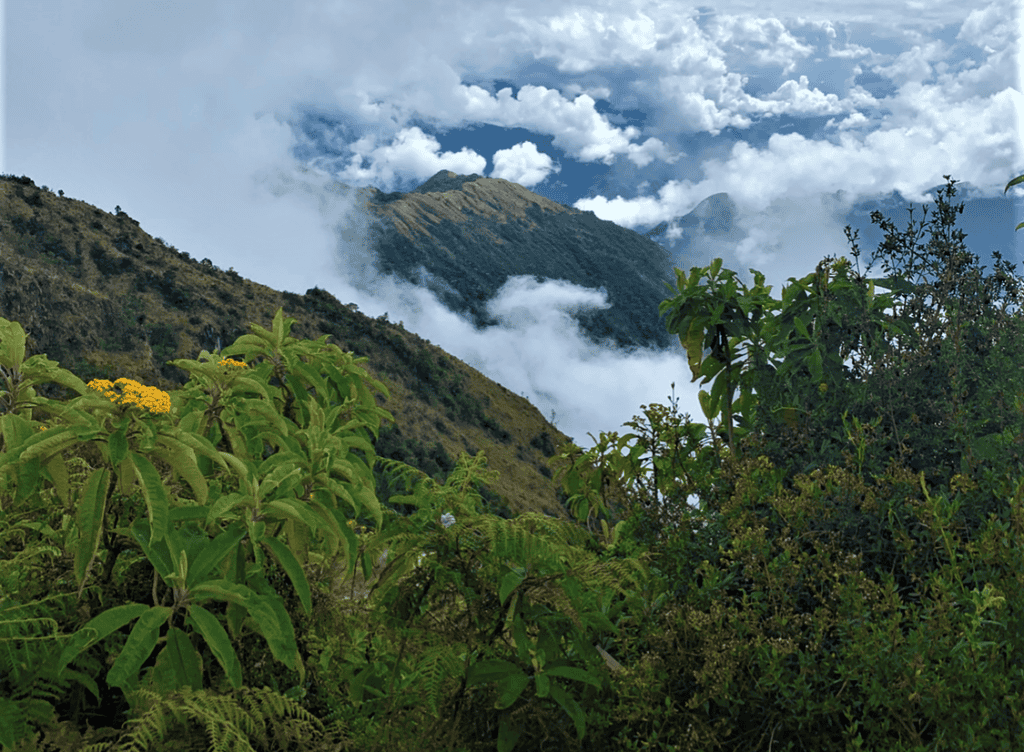
Day 3 Of Inca Trail 4 Days – Paqaymayo Camp – Winaywayna
I woke softly up to the Sherpa wake-up team and hot water outside my tent door again on the third Inca Trail trekking day. I felt a bit tired but okay.
Despite constant reminders during the night of my poor decision to NOT bring the extra sleeping pad, waking up freezing, my extra clothes serve as my insulation and allow for at least some sleep.
After the routine morning packing and breakfast, this third day of hiking starts with a challenge.
What the G Adventures guides call the Sherpa Challenge – where we the guest/tourist/rookie hikers, can try out as a Sherpa for the first half-hour or so of the day.
Of course, that is a challenge I am not missing out on.
The G Adventures Sherpa Challenge
We are a couple of girls and a bunch of guys starting out on the G Adventures sherpa challenge with the oversized backpacks on our shoulders, while the rest of the group prefers to hold on to their daypack.
I start the ascent somewhere in the middle of the group and stick to my normal game plan.
One foot before the other at a slow but steady pace. Staying clear of acid in my thighs or too little oxygen in my lungs.
As we ascend, one by one, the chicas and some of the chicos throw in the towel and hand over the humongous backpack to the responsible super-Sherpa.
I think at this point I thoroughly benefit from my army training and many hours of putting one foot before the other without thinking too far ahead.
Further up the ascent, I also start passing some of the other guys who started out too fast and are now “out of juice”. In fact, it turns out that slowly but surely, I passed all of the other guys in the G Adventures Sherpa challenge!
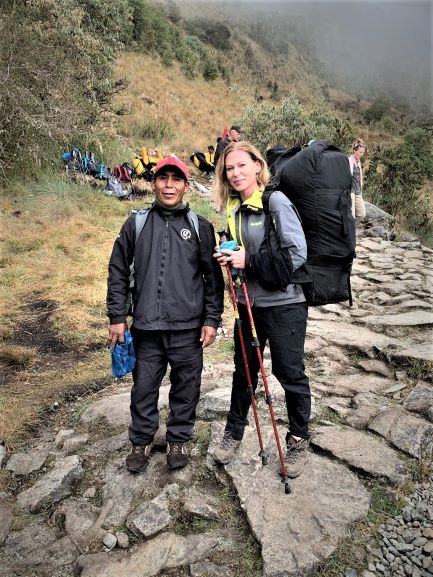
Not that I am super competitive, really, (or at least, so I thought) but I actually WON the whole Sherpa Challenge!
I have to admit I feel more than a little proud. Although I know “my” Sherpa is a tiny little guy carrying this huge backpack millions of altitude meters every year.
But I am not used to that, so I decided to be very satisfied with my achievement. Look at that smile!
Heading On To Runquraqay And Phuyupatamarca (Puh)
After catching our breath and admiring the view, the hike continues uphill for a while, now with the luxury of only my tiny little daypack.
On this third day of the Inca Trail hike, you will cross two more passes and several Inca ruins.
The first pass to be conquered is Runquraqay (yeah, I can not pronounce that either) at 3950 meters, where on a clear day, hikers can catch a glimpse of the snowcapped Cordillera Vilcabamba, a mountain top on the horizon.
Further, we hike through cloud forests before a gentler climb to the second pass of the day.
Walking through original Incan constructions, the highest point of this pass is 3700 meters, where on clear days, you can enjoy the views of the Urubamba Valley or the Sacred Valley of the Incas.
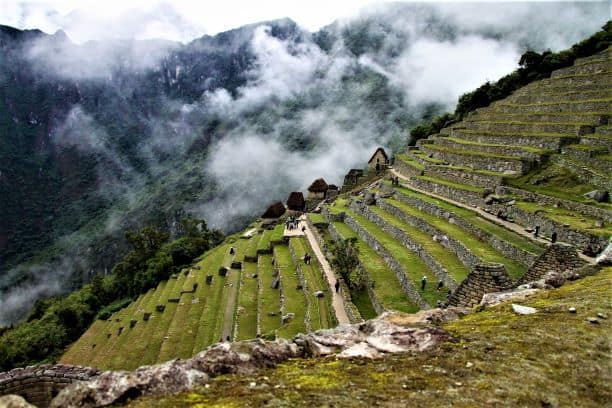
At 3650 meters we reach the ruins of Phuyupatamarca (puh), which roughly translated means “the town above the clouds”.
At this altitude, Phuyupatamarca contains Inca ruins with five small stone baths. During the wet season, in ancient times, they provided the Incas with constant fresh running water.
It is impossible not to be impressed again and again with the advanced engineering and agricultural solutions the Incas developed along the trail to survive and live in the mountains all those years ago!
The Mountain Ridge Infinite View
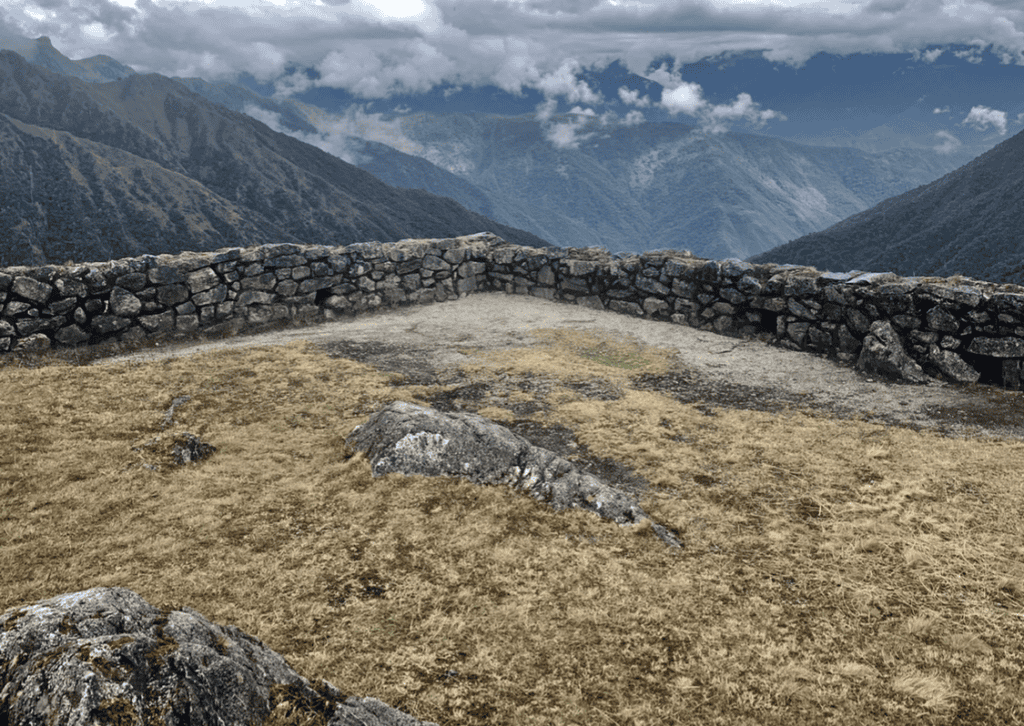
A lot of the hike on day three is following a mountain ridge, and I am walking this ridge practically alone in complete silence having “escaped” from my group a little.
There are floating pieces of clouds passing like ghosts above and below us in shifting patterns.
There is hardly any wind, and the view is of mountain ridges behind mountain ridges in the distance. In multiple shades of green and blue immersed in clouds for as far as the eye and horizon allow.
The ambiance surrounding this mountain’s silence and the indescribable energy of the majestic views is hard to put into words.
It actually made me choke up a few times along the way, quite overwhelming at times. I really think you just have to see it.
The day ends with a lot of downhill, good for sore muscles in the thighs but not so good for the knees!
Forever Young At The End Of Day Three?

The last campsite of the Inca Trail is the Winaywayna ruins, in plain English “forever young”.
Winaywayna is a ruin that consists of upper and lower house clusters, interconnected by a long steep staircase with accompanying fountain structures that often are referred to as “baths.”
A large area of what probably was agricultural terraces lies just north of the house-staircase complex. This site is located at 2650 meters, where we find our tents for the last night in the mountains.
We can see the endpoint long before we get there, and when we get there, we realize that here, we are definitely not alone!
This appears to be the collection point of a lot of different trekking groups wandering the Inca Trail.
The last stop before passing through the Sun Gate above Machu Picchu early on the last day.
We find our assigned tents among a myriad of other colorful tents from other guided groups.
Our G Adventures team has of course found a perfect spot for the dinner tent, which is served with three courses (as normal) in this little tent city just a couple of hours away from Machu Picchu.
The next day is the last walk, heading for the last leg of the Inca Trail.
The Sun Gate Machu Picchu
The final day of the Inca Trail hike starts a little while before sunrise to reach the Sun Gate Machu Picchu before the sun appears over the horizon.
So we wake up, pack our stuff, and start walking to reach the checkpoint to enter when it opens in pitch dark.
From camp, the hike starts in the dark with headlamps while the horizon to the east slowly starts lighting up as we walk.
It gradually gets lighter, a grey appearing on the sky to the right of the trail.
Slowly, the terrain and surroundings become visible as the sky turns to a cold pink above the mountains on the horizon. It is incredibly beautiful.
The sun appears just as the group reaches the Sun Gate Machu Picchu, and the Sun Gate is where the Inka Trail trek ends.

We reached the Sun Gate along with everyone else early this morning.
It is a stunning sight.
In the tiny pink light from the morning sun, just as it gently puts its cold veil over the mountains, slowly heating up the earth.
Transcending The Sun Gate Machu Picchu In Light Pink Sunrise
The moment you walk through the ancient stone sun gate, you catch the first views of the breathtaking city ruins of Machu Picchu below the gate, only a short downhill stroll away.
Hiking down the last path towards Machu Picchu, the air gets warmer and colors thicker and greener.
When you reach the entrance to the old Machu Picchu city, it has already become a warm summer day.
Suddenly, our mountain group is transformed from trekkers to normal tourists, it seems.
Like the ones that came by train this same morning and took the bus up the steep mountainsides to experience the magic of the ancient mountain structures.
But unlike them, we are all dirty and sweaty with bad hair and rough clothes.
We feel just the way you should feel when you have completed a four-day mountain trek with a respectable altitude to reach your goal – happy and tired. And a little melancholic, as of course it is never really about the goal, is it – but about the journey.
Finally Entering The Ancient City Of Machu Picchu
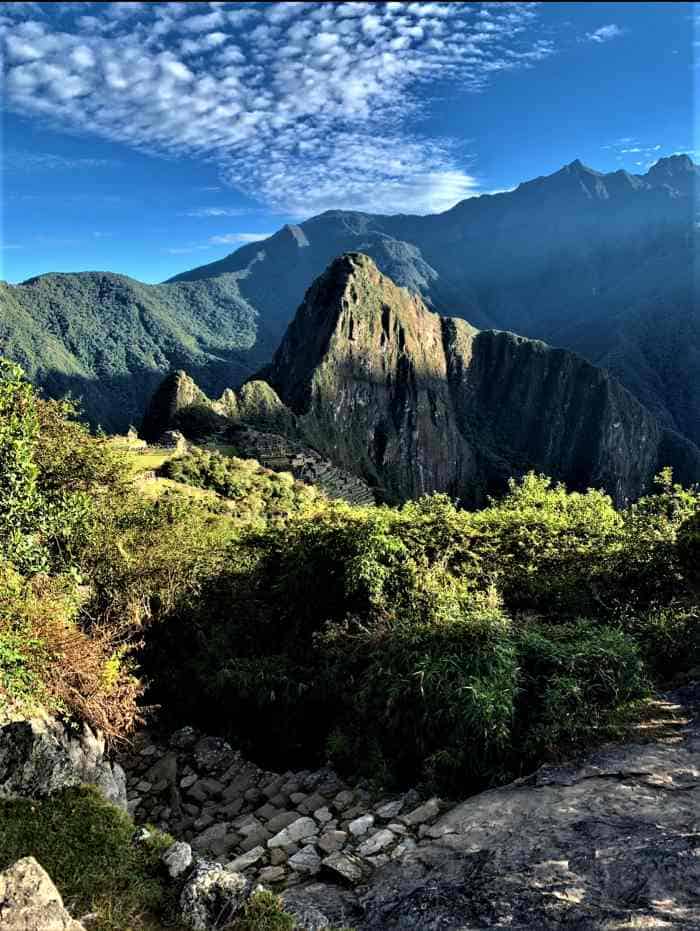
As we enter the structures of the ancient city in the mountains, the realization of its grandeur is striking!
You can see from the distant Sun Gate that it is really a large area.
Yet, when in the midst of it you see every little stone, fence, wall, and house, that was constructed here all those years ago. It is HUGE!
The work is exquisite, the solutions incredible, and the location impossible. How did they do it? I encourage you to just enjoy the photos, as trying to describe the sight will be a little waste of energy.

Of course, I encourage you even stronger to get there yourself, do the entire hike, or just take the day trip to Machu Picchu from Cusco to experience it.
One option while inside Machu Picchu is to visit the Inca Bridge if time allows.
Or just catch the bus to Aquas Calientes, the little city below Machu Picchu from where your train back to Cusco leaves.
In Aquas Calientes, you have time to eat and relax (and have a glass of wine or a pint?) before your train back to Cusco in the afternoon when this whole experience comes to an end.
Wrap-Up Inca Trail Booking 4 Days Trek In Spectacular Peru
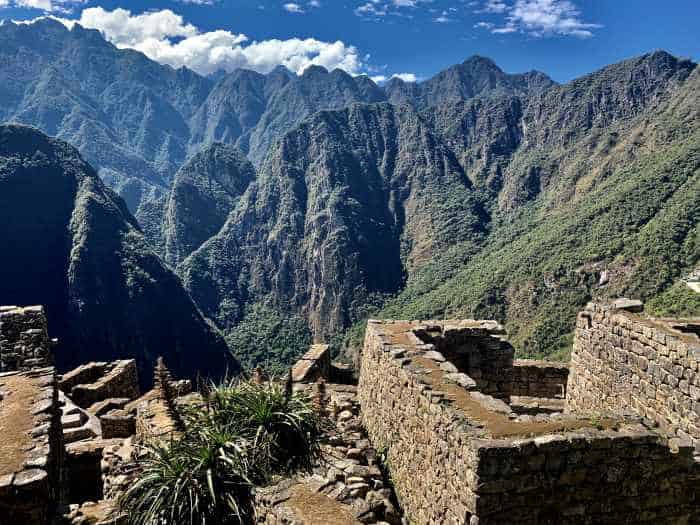
You Change After Walking The Ancient Footsteps Of The Incas in Peru. Not just after the Inca Trail, of course, or Machu Picchu.
People change after experiencing large moments, experiences that simply humble their existence and expand their minds and understanding of the vast history and humanity.
And the Inca Trail to Machu Picchu is one of these experiences that gives you perspective and both the time and the infinite views to meditate!
My expectations about this four-day trek in the Peruvian mountains were NOTHING like the reality. The real-life Inca Trail was way better.

Final words: Glamping Inca Trail Luxury
For starters, the level of Inca Trail luxury in the mountains with G Adventure is nothing but impressive.
Calling it a glamping Inca Trail is not to exaggerate, the service and food are way beyond what I could have dreamed about!
The adventure and experience in itself – to wander the mountains in Peru where people have been walking out of necessity and a sense of adventure for centuries, in the middle of the large nature, is just amazing!
Like when you picture the planet from the point of view of outer space, the magnitude of the Milky Way, and ponder upon your own microscopic place in the mix of time and space (in a good way, of course!)
If you want to experience this magnificent place in the Peruvian mountains without doing several days of trekking, it is possible to buy a day pass for only Machu Picchu as well.
Check out this comprehensive guide from Along Dusty Roads on all the details, tickets, and entry options you have for visiting Machu Picchu in 2022.
Regulated with new measures both due to Covid 19 and a need for a sustainable display of the ancient ruins.
Related blog posts:
Lost City Hike Colombia Guide By An Expert (Ciudad Perdida)
Ultimate Inca Trail Packing List From An Avid Hiker
21 Best Travel Essentials For Women from An Expert Female Traveler
